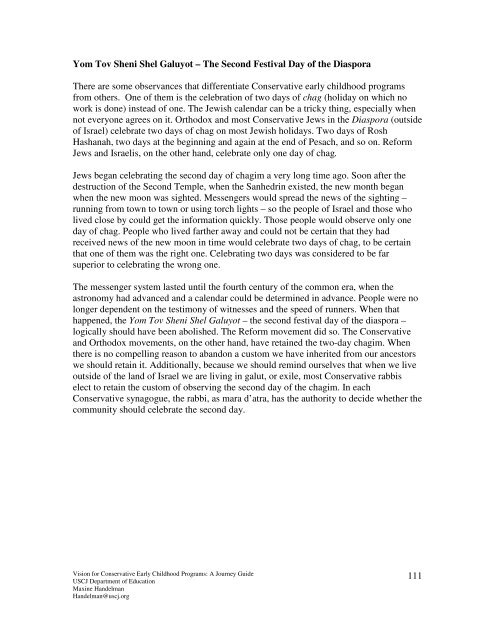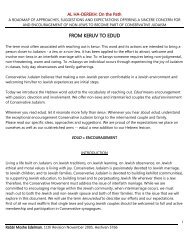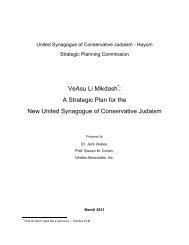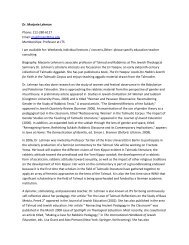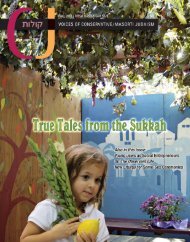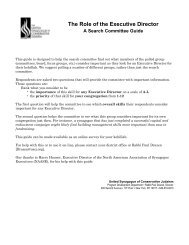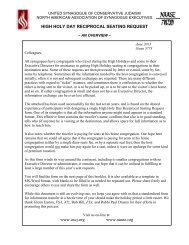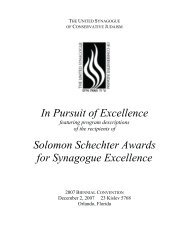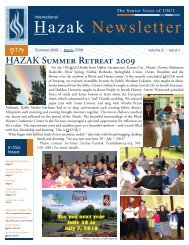Vision for Conservative Early Childhood Programs: A Journey Guide
Vision for Conservative Early Childhood Programs: A Journey Guide
Vision for Conservative Early Childhood Programs: A Journey Guide
Create successful ePaper yourself
Turn your PDF publications into a flip-book with our unique Google optimized e-Paper software.
Yom Tov Sheni Shel Galuyot – The Second Festival Day of the Diaspora<br />
There are some observances that differentiate <strong>Conservative</strong> early childhood programs<br />
from others. One of them is the celebration of two days of chag (holiday on which no<br />
work is done) instead of one. The Jewish calendar can be a tricky thing, especially when<br />
not everyone agrees on it. Orthodox and most <strong>Conservative</strong> Jews in the Diaspora (outside<br />
of Israel) celebrate two days of chag on most Jewish holidays. Two days of Rosh<br />
Hashanah, two days at the beginning and again at the end of Pesach, and so on. Re<strong>for</strong>m<br />
Jews and Israelis, on the other hand, celebrate only one day of chag.<br />
Jews began celebrating the second day of chagim a very long time ago. Soon after the<br />
destruction of the Second Temple, when the Sanhedrin existed, the new month began<br />
when the new moon was sighted. Messengers would spread the news of the sighting –<br />
running from town to town or using torch lights – so the people of Israel and those who<br />
lived close by could get the in<strong>for</strong>mation quickly. Those people would observe only one<br />
day of chag. People who lived farther away and could not be certain that they had<br />
received news of the new moon in time would celebrate two days of chag, to be certain<br />
that one of them was the right one. Celebrating two days was considered to be far<br />
superior to celebrating the wrong one.<br />
The messenger system lasted until the fourth century of the common era, when the<br />
astronomy had advanced and a calendar could be determined in advance. People were no<br />
longer dependent on the testimony of witnesses and the speed of runners. When that<br />
happened, the Yom Tov Sheni Shel Galuyot – the second festival day of the diaspora –<br />
logically should have been abolished. The Re<strong>for</strong>m movement did so. The <strong>Conservative</strong><br />
and Orthodox movements, on the other hand, have retained the two-day chagim. When<br />
there is no compelling reason to abandon a custom we have inherited from our ancestors<br />
we should retain it. Additionally, because we should remind ourselves that when we live<br />
outside of the land of Israel we are living in galut, or exile, most <strong>Conservative</strong> rabbis<br />
elect to retain the custom of observing the second day of the chagim. In each<br />
<strong>Conservative</strong> synagogue, the rabbi, as mara d’atra, has the authority to decide whether the<br />
community should celebrate the second day.<br />
<strong>Vision</strong> <strong>for</strong> <strong>Conservative</strong> <strong>Early</strong> <strong>Childhood</strong> <strong>Programs</strong>: A <strong>Journey</strong> <strong>Guide</strong><br />
USCJ Department of Education<br />
Maxine Handelman<br />
Handelman@uscj.org<br />
111


